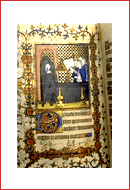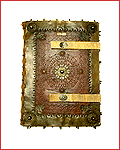|
The smaller, illuminated fifteenth-century book of hours
shown here depicts such a choir, a group of tonsured monks chanting a funeral
mass from a gradual placed on a wooden stand
|
.
|

|
To withstand daily use, this gradual is bound with embossed
leather stretched over wooden boards. Metal bosses, or ornaments, decorate
and protect the cover, and a metal tab provides support for the text block
when it is used in an upright position.
|
